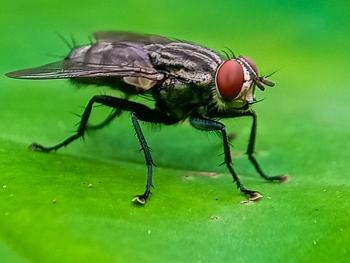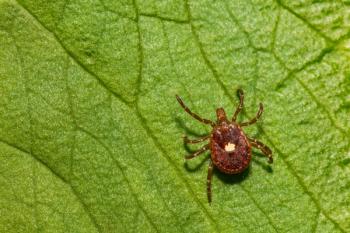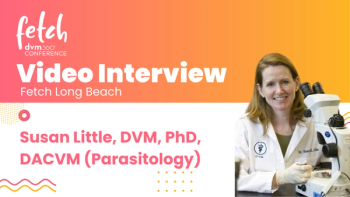
Neospora caninum (Proceedings)
Neospora caninum, a recently discovered cyst-forming protozoan parasite, is a causative agent of ascending neuromuscular disease in dogs and of abortion in cattle worldwide.
Neospora caninum, a recently discovered cyst-forming protozoan parasite, is a causative agent of ascending neuromuscular disease in dogs and of abortion in cattle worldwide. The parasite life cycle is indirect. Three stages of the parasite occur – tachyzoites, tissue cysts, which occur in the intermediate host (e.g., cattle), and oocysts which are shed by the definitive host. Tachyzoites are approximately 6 × 2 µm. Microscopic tissue cysts occur within the central nervous system (CNS). They may be round or oval in shape, measuring up to 107 µm in length. Unsporulated oocysts, approximately 12 µm in diameter, have been found in the feces of naturally and experimentally infected dogs. Sporulation to the infective stage occurs in the external environment. However, further details regarding the frequency and duration of shedding, recrudescence in the definitive host, or survival in the environment are lacking at this time.
Dogs acquire infection through ingestion of infected tissues. However, cattle can become infected through both vertical (oocyst-induced) and horizontal (tachyzoite-induced) transmission routes. Cattle acquire infection by ingestion of oocysts through contaminated feed or water and oocyst-induced infections have been implicated as the source of abortion storms. Although horizontal transmission is likely necessary to sustain the parasite in a population, transplacental transmission in cattle aids in perpetuating infections within herds.
Because of the pathogenic effects of neosporosis in cattle and the documented association between seroprevalence in cattle and dog density both on and off the farm, most studies have focused on the urban form of the life cycle. However, the association between seroprevalence in cattle and the abundance of coyotes (Canis latrans) and grey foxes (Urocyon cinereoargenteus), coupled with the discovery that coyotes can be definitive hosts for the parasite suggest that a sylvatic cycle may also be important. The existence of such a cycle is further supported by the presence of the organism in populations of both black-tailed (Odocoileus hemionus columbianus) and white-tailed (Odocoielus virginianus) deer. Molecular evidence indicates that the isolate from white-tailed deer was identical to those from domestic ruminants.
Based on serologic surveys, the array of wildlife species that could serve as intermediate hosts for N. caninum has been expanding. Antibodies have been detected in moose (Alces alces) in Minnesota and Alaska. Antibodies have also been detected in bison (Bison bison) in Iowa and Alaska. Finally, caribou (Rangifer tarandus) and musk ox (Ovibos moschatus) in Alaska also had antibodies to N. caninum. Prevalences in animals in Alaska are typically lower than those in the continental US; although this may be due to differences in habitat, it may also be a reflection of the different serologic test methodologies used.
In addition to land mammals, antibodies to N. caninum have also been demonstrated in marine mammals including sea otters (Enhydra lutris) from Washington and California and Atlantic bottlenose dolphins (Tursiops truncatus) from Florida. Of Alaskan marine mammals, sea lions (Zalophus californianus), harbor seals (Phoca vitulinaa), and ringed seals (Phoca hispida) had demonstrable antibodies to N. caninum. Whether the presence of antibodies indicates active infection is unknown at this point, primarily because of the difficulty in isolating N. caninum from naturally-infected tissues.
Although numerous potential intermediate hosts have been identified, until recently, only domestic dogs and coyotes were shown to be competent definitive hosts. Serologically, antibodies have been demonstrated in several canid species including red fox (Vulpes vulpes) from a variety of countries and gray fox and gray wolves (Canis lupus) in the US. Seroprevalences range widely depending on species and location, but, do indicate that gray foxes, red foxes and gray wolves could be additional definitive hosts for N. caninum. However, canids may also be intermediate hosts, as demonstrated by domestic dogs in which neuromuscular disease associated with tissue cysts occurs. Recently, red foxes have been documented to be both intermediate and definitive hosts. Additionally, dogs do not seroconvert when shedding oocysts, an observation which was also confirmed in red foxes. The host status of gray wolves and gray foxes remains undetermined at this time.
The source of infection for wild canids is unknown; however, it is speculated that wild ruminant tissues obtained via depredation or scavenging is a primary route. A coyote / white-tailed deer cycle and wolf / moose or wolf / white-tailed deer cycles have been proposed. For canids, such as red fox whose diet is not based on large herbivores, the source of infection may be different. One hypotheses implicates rodents as a source of infection since rodents constitute a large portion of the diet of red foxes during certain times of the year and N. caninum has been documented in several rodent species.
References available upon request
Newsletter
From exam room tips to practice management insights, get trusted veterinary news delivered straight to your inbox—subscribe to dvm360.



